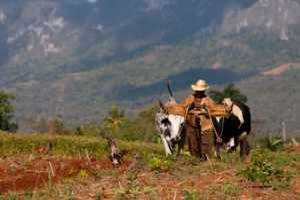Some differences between Cuban and British allotments
By Clodagh and Dick Handscombe who have grown vegetables for a combined 120 years since the age of five including on mini plots, school vegetable gardens, allotment size vegetable gardens and eventually a 800 square metre allotment in Spain where they have lived for twenty years.

Cuban Farmer
About five years ago they visited the island of Cuba where the collapse of the Soviet Union and US sanctions have forced the country into thinking outside of the conventional in their agriculture.
Background to a visit to Cuba
Dick started to grow vegetables by helping grandparents with their allotments in Leicester and Pirton and parents in West London during the second world war. He has therefore always recognised the important role of allotments in maintaining healthy diets in times of food shortages. Likewise Clodagh born after the war years.
So when they met up in Spain many decades later it was natural to started a productive allotment as described in their other articles on this site. Always on the alert for best practices they visited Cuba a few years ago to find out how the country had changed from importing most of its food to being self sufficient within a decade after the break up of their major supplier, the USSR.
They visited allotments outside villages, alongside factories, at schools and on roadsides as well as the equivalents in the courtyards of blocks of flats and on rooftops. This article presents some of their findings relevant to UK allotment holders .
Things that could to be done or done better
The most relevant ideas are summarised below.
- See the allotment as the source of healthy food , not just food. Grow edible culinary/medicinal herbs and flowers as well as vegetables and soft fruits without chemical residues. Grow vegetables with high vitamin contents and other healthy benefits..
- Grow ecologically, avoiding inorganic chemical products – fertilizers, insecticides and fungicides for which there are now good natural alternatives.
- Avoid major insect and fungal problems by growing at more natural rates by reducing the amount of supplementary feeds and extent of watering. To achieve this feed the soil and not the plants .
- Compost all vegetable and fruit waste from the kitchen , allotment and house garden in a compost heap and in a supplementary wormery. Worm compost is excellent for enriching raised beds as well as regular vegetable beds. Cuba had become the vermiculture experts of the world.
- Collect as much horse, sheep, goat, cow, pigeon, rabbit , guinea pig , budgerigar and healthy chicken manure as you can and add some into the compost heap as an accelerator and to improve its nutrient content. Your own chickens and rabbits can produce an amazing amount of natural fertilizer as well as healthy meat and eggs. Some Cubans fed catfish in ponds alongside their rabbits with rabbit droppings but we have not done the same to our goldfish!
- Aim towards a 25% to 40% percent of added composts to the top 30 centimetres of your soils to lighten it and improve it’s fertility. Raised beds help achieve this most rapidly.
- To avoid having to compost gluts once the deep freeze is full start to dry and bottle vegetables as well as fruit. We use a Dorrex tray dryer several nights a week through out the year for vegetables, fruit and herbs.
- Every village in Cuba had a trained agronomist to help increase productivity and encourage children to start to grow vegetables, herbs and fruit in local school gardens. Why not do likewise by supporting your local school’s gardening club and perhaps offering practical apprenticeships on your allotment? Under close guidance of course!
Have a look yourself if visiting CUBA
Throughout our 1000 plus kilometre journey we found Cubans very approachable and friendly. Photographs of our garden and allotment were perfect visiting cards.
One lasting impression we have is that Cuba was avoiding becoming dependent on fast foods by aiming to sustain a good diet and health from home grown local produce and minimising the food miles from growing site to homes.
We have now written six books re gardening in Spain including the best seller Growing Healthy Vegetables in Spain – ISBN 978-84-89954-53-3 and have a regular radio programme on Spanish radio. If you are interested in growing vegetables in the Mediterranean climate or more ideas for growing in a globally warmed southern England the book can be obtained most easily in the UK from Amazon
© Clodagh and Dick Handscombe May 2008.
Allotment Information
- Allotment & Garden Paths
- Allotment Growing as You Get Older
- Allotment History – A Brief History of Allotments in the UK
- Allotment History – Cultivating a 19th Century Allotment by Dr Lesley Acton MA Ph.D
- Allotment History – The First Allotments by Dr Lesley Acton MA Ph.D
- Allotment Journey – A Step to Sustainable Living
- Allotment Regeneration – Case Study
- Allotments & Children
- Allotments & The Law – Legal Aspects of An Allotment
- Allotments – Some Tips to Get You Started
- Clearing a New Allotment or Vegetable Plot
- Cuban Vegetable Growing Practices can Benefit your Allotments
- Finding an Allotment – How to Find an Allotment
- Health and Safety in the Allotment & Garden
- Here is How Having and Maintaining a Back Garden Allotment Could Help You to Sell Your Home
- How to Create a Charming Sitting Area in Your Allotment
- How to Ensure the Security of your Allotment
- How To Pick The Right Shed For Your Allotment
- How to reduce the costs of running your allotment
- Improving Security on Allotments to combat Vandalism and Theft
- The Allotment – The City Dwellers bit of Country
- Vacant Allotment Plots – What To Do With Them?
- Why People Grow Our Own – Our Plots
- You Have a New Allotment!



